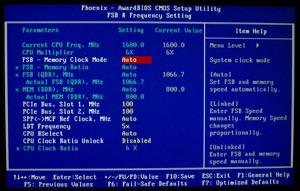DFI LANParty UT NF680i LT SLI-T2R nForce 680i LT
BIOS and Overclocking
DFI is known for their flexible custom BIOS releases for their LANParty UT series, which give the overclocker/tweaker a lot of flexibility to take their components to their maximum limits. DFI generally includes many of the options which motherboard makers hide from end users in order to keep accidental mis-configuration scenarios down. Likewise, DFI does not have many voltage caps or artificial limits - they let you run wild with this board, which is great as long as you know how to configure it properly.
Their LANParty UT nForce 680i LT SLI board is equipped with a PhoenixBIOS which is modified with DFI's GenieBIOS menus, which hold the majority of the motherboard's overclocking control set. While the board "officially" supports up to 1333 MHz FSB and 800 MHz DDR2 memory, the board has BIOS-level maximums of 2500 MHz FSB and 1400 MHz DDR2 memory, so there is a lot of leeway here. The board also has voltage controls for every major component with small iteration levels, including DDR2 voltage levels up to 3.0V, Northbridge up to 1.75V, Southbridge up to 1.85V, and vCore up to 1.6V.
|
FSB and Multiplier Controls |
Voltage Monitoring and Alteration |
The motherboard also supports the ability to save multiple BIOS configurations which can be recalled if needed based on hotkeys. For example, you could have a "stock" BIOS menu which runs your system at non-overclocked speeds, along with an "overclocked" menu with your CPU and memory running at higher levels, toggling between them at boot. You can save up to four configurations using this system, which can be handy if you're pushing this board well beyond its intended specifications.
|
Thermal and Fan Speed Controls |
CMOS Reloaded Menu |
DFI has implemented a new digital PWM fan speed control system with this board, which they claim to is more accurate and more flexible compared to traditional methods. In the BIOS, you can set minimum and maximum temperature levels which you want the CPU to run between, while the motherboard will try to balance these levels by constantly altering fan speed on the fly. Unfortunately, with the shipping BIOS of this motherboard, digital PWM fan speed support was not as flawless as we hoped for. Many times throughout our testing, our board would kick into a higher speed level to cool the processor down, but would never move itself down to a lower fan speed level when the processor reached a reasonable temperature, leading to an overall noisy system. We wish that DFI would allow for manual control of the fan speeds (i.e., run at 50% speed at all times) as well, instead of relying solely on this questionably better PWM system.
When we first received the board, DFI claimed that internal tests revealed that they easily hit front side bus speeds of over 500 MHz (2000 MHz FSB), which is a strong claim. In their labs, they have overclocked similar boards up to 525 MHz (2100 MHz FSB) at stable levels, providing fairly high expectations for the board. Unfortunately, throughout our testing, we were not able to meet these levels with our platform, even with the help of DFI's engineers and a series of beta BIOS revisions.
Our sample board was able to hit 1800 MHz FSB at stable levels, a solid overclock for a 1066 MHz FSB based dual-core processor, although not quite to the stratospheric levels which were claimed to be possible. DFI certainly does provide the tools for heavy overclocking, and their custom cooling systems do an excellent job of keeping the chipset cool. However, every board will overclock to different levels, ours simply didn't fare as well as expected. For the record, the Nvidia reference / eVGA nForce 680i LT reference board we tested a few weeks back was able to overclock slightly further, hitting up to 1933 MHz, although it too was only stable in the 1800-1866 MHz FSB range. However, we did find overclocking to be far easier on the eVGA platform compared to our DFI board.










